Figure 2. NKG2D ligands are induced by DNA damaging agents and DNA synthesis inhibitors.
A) No induction of ligands in C1 or C2 cells by heat shock, and hypoxia. Cells were stained with NKG2D tetramers or Rae1 antibody. B, C) Upregulation of ligands on mouse cells (B) or human fibroblasts (passage 3-6) (C) by DNA damaging agents and DNA synthesis inhibitors (16 hr treatment). Treated cells (solid lines) were compared to untreated cells (dashed lines) or to treated cells stained with control tetramers or isotype control antibodies (filled histograms). D) Aphidicolin treatment upregulates NKG2D ligands on T cell blasts (left panel, key as defined above) and elevates their sensitivity to IL-2 activated NK cells (right). NK cells were incubated with treated (squares) or untreated (circles) target cells in the absence (filled) or presence (open) of NKG2D antibody. In repetitions of the experiment, untreated cells were killed but always substantially less well than treated cells.

